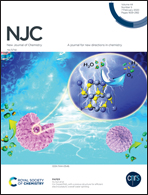A Cu2O/Cu/carbon cloth as a binder-free electrode for non-enzymatic glucose sensors with high performance
Abstract
Enzyme-free glucose sensors have drawn considerable attention in clinical diagnosis, the food industry and other fields; they significantly avoid the intrinsic defects of enzyme-based biosensors. A flexible free-standing non-enzymatic electrochemical sensor was successfully fabricated for the first time via potentiostatic electrochemical deposition of Cu2O/Cu nanocomposites on carbon cloth for glucose detection. The Cu2O/Cu/carbon cloth nanocomposite electrode exhibits exceedingly good sensitivity (6952 μA cm−2 mM−1), an ultralow detection limit (60 nM (S/N = 3)) and a wide linear range (1 to 1555 μM). In addition, it presents satisfactory anti-interference ability, stability and reproducibility. These admirable characteristics were considered to be due to the synergistic effects of the highly conductive carbon cloth with multiple channels and more active sites combined with the catalytic activity of Cu2O/Cu. Furthermore, because of its facile implementation and low capital cost, this Cu2O/Cu/carbon cloth will attract interest and broaden the horizons of commercial glucose sensors and other applications.



 Please wait while we load your content...
Please wait while we load your content...